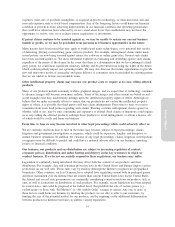Electronic Arts 2008 Annual Report Download - page 91
Download and view the complete annual report
Please find page 91 of the 2008 Electronic Arts annual report below. You can navigate through the pages in the report by either clicking on the pages listed below, or by using the keyword search tool below to find specific information within the annual report.
Our business is highly dependent on the success and availability of video game hardware systems
manufactured by third parties, as well as our ability to develop commercially successful products for
these systems.
We derive most of our revenue from the sale of products for play on video game hardware systems (which we
also refer to as “platforms”) manufactured by third parties, such as Sony’s PlayStation 2 and PLAYSTATION 3,
Microsoft’s Xbox 360 and Nintendo’s Wii. The success of our business is driven in large part by the
commercial success and adequate supply of these video game hardware systems, our ability to accurately
predict which systems will be successful in the marketplace, and our ability to develop commercially
successful products for these systems. We must make product development decisions and commit significant
resources well in advance of anticipated product ship dates. A platform for which we are developing products
may not succeed or may have a shorter life cycle than anticipated. If consumer demand for the systems for
which we are developing products is lower than our expectations, our revenue will suffer, we may be unable to
fully recover the investments we have made in developing our products, and our financial performance will be
harmed. Alternatively, a system for which we have not devoted significant resources could be more successful
than we had initially anticipated, causing us to miss out on meaningful revenue opportunities.
Our industry is cyclical, driven by the transition from older video game hardware systems to new ones.
As we continue to move through the current cycle, our operating results may be volatile and difficult to
predict.
Video game hardware systems have historically had a life cycle of four to six years, which causes the video
game software market to be cyclical as well. The current cycle began with Microsoft’s launch of the Xbox 360
in 2005, and continued in 2006 when Sony and Nintendo launched their next-generation systems, the
PLAYSTATION 3 and the Wii, respectively. During fiscal 2008, the installed base of each of these systems
continued to expand and, as a result, sales of our products for these systems have also increased significantly.
At the same time, however, demand for video games for prior-generation systems, particularly the original
Xbox and the Nintendo GameCube, has declined significantly. Although we expect to continue developing and
marketing new titles for the prior-generation PlayStation 2 in fiscal 2009, we only expect to release one title
for the original Xbox and no titles for the Nintendo GameCube. As a result, we expect our sales of video
games for prior-generation systems to continue to decline. The decline in prior-generation product sales,
particularly the PlayStation 2, may be greater or faster than we anticipate, and sales of products for the new
platforms may be lower or increase more slowly than we anticipate. Moreover, we expect development costs
for the new video game systems to continue to be greater on a per-title basis than development costs for prior-
generation video game systems. As a result of these factors, during the next several quarters, we expect our
operating results to be more volatile and difficult to predict, which could cause our stock price to fluctuate
significantly.
If we do not consistently meet our product development schedules, our operating results will be
adversely affected.
Our business is highly seasonal, with the highest levels of consumer demand and a significant percentage of
our sales occurring in the December quarter. In addition, we seek to release many of our products in
conjunction with specific events, such as the release of a related movie or the beginning of a sports season or
major sporting event. If we miss these key selling periods for any reason, including product delays or delayed
introduction of a new platform for which we have developed products, our sales will suffer disproportionately.
Likewise, if a key event to which our product release schedule is tied were to be delayed or cancelled, our
sales would also suffer disproportionately. Our ability to meet product development schedules is affected by a
number of factors, including the creative processes involved, the coordination of large and sometimes
geographically dispersed development teams required by the increasing complexity of our products and the
platforms for which they are developed, and the need to fine-tune our products prior to their release. We have
experienced development delays for our products in the past, which caused us to push back release dates. In
the future, any failure to meet anticipated production or release schedules would likely result in a delay of
revenue and/or possibly a significant shortfall in our revenue, harm our profitability, and cause our operating
results to be materially different than anticipated.
Annual Report
15
























